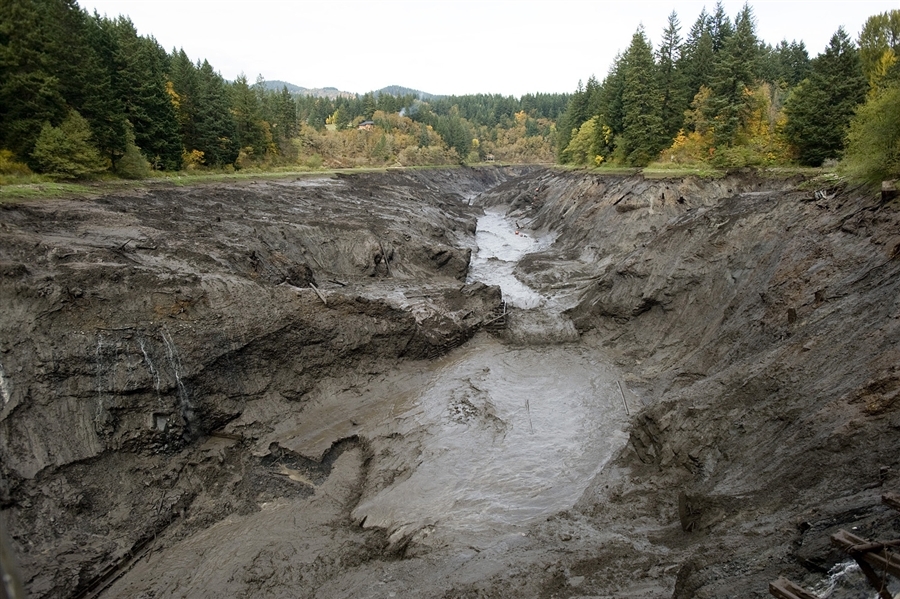The fishing occurred around the clock during the peak of late July to mid-September. Someone always was angling in the 200 to 300 yards upstream of the state Highway 14 bridge. It is a scenic place, and somewhat sheltered from the incessant wind of the Columbia Gorge.
Each morning, another 15 to 20 sportsmen were fishing "the riffles,'' about a mile upstream.
"There are guys who based their fishing lives on the White Salmon,'' said John Weinheimer, a Washington Department of Fish and Wildlife fish biologist based in Carson.
And for good reason.
The lower White Salmon has been one of the best summer steelhead fishing spots in Washington.
In 2009, the sport catch was 6,967 summer steelhead, ranking No. 6 in Washington. In 2010, the catch was 2,807, ranking the lower White Salmon No. 8 among summer steelhead spots.
The spot was a cold-water refuge for the thousands of steelhead headed to Eastern Washington, Eastern Oregon, and Idaho.
Water temperatures in the pools of the Columbia can approach lethal levels in late July and August. The fish "dip-in'' to cool spots like the mouth of Wind River, Drano Lake, and the mouth of the White Salmon.
Anglers figured this out long, long ago. The White Salmon was an especially good spot. Condit Dam trapped the silt of the river, keeping the mouth relatively deep and cold. You could troll, but in recent years the fishery was mostly bobbers-and-prawns.
"You could fish pretty close together in there and not get in each other's way,'' Weinheimer said.
With the breaching on Wednesday of Condit Dam 3.3 miles up the White Salmon, the mouth of the river may fill with silt. Go look at the mouth of Rock Creek, Wind River, Hood River, or the Klickitat River.
Sportsmen probably are losing one of the best steelhead fishing holes in the state. Those migrating steelhead may be losing one of their best cold-water refuges.
So amid all the giddiness of the dam removal, and the potential for salmon and steelhead to use "new'' habitat upstream, take a moment to mourn the likely loss of a great fishing spot.
Fish biologists estimate the removal of Condit will open 33 miles of new habitat for summer steelhead, 21 miles for coho, 13 miles for spring chinook, and eight miles for fall chinook.
Estimates vary, but a 2004 U.S. Geological Survey model predicts 950 to 1,225 coho, 800 to 1,000 fall chinook, 300 to 550 summer steelhead and 600 to 800 spring chinook will use the new habitat.
Nobody really knows how productive — or not — the watershed will be.
I think it's likely a great summer steelhead fishery will be lost as the river mouth silts in and becomes marginally fishable. I think it is questionable whether new populations of salmon and steelhead will be generated.
I hope I am wrong.
Wednesday's view
The muddy waters from Northwestern Lake, the 97-acre reservoir behind Condit Dam, arrived at the mouth of the White Salmon at 12:30 p.m.
Initially, there were narrow, muddy plumes along each shoreline with green water in between.
Five minutes later, the whole river was a kaleidoscope of browns and beiges. Logs and mats of woody debris were floating under the state Highway 14 bridge.
The debris moved through relatively quickly.
There was a odd smell, too, like the scent of an estuary at low tide only significantly stronger.
Dennis Gathard of Gathard Engineering Consulting of Seattle was collecting sediment samples mid-afternoon Wednesday off the bridge.
While it appeared the muddy water was virtually still, Gathard said there was a dense undercurrent moving the heavier sediment downstream.
"Nobody's done this before,'' Gathard said. "New understanding is being developed as we speak.''
The future
The Washington Department of Fish and Wildlife has closed fishing indefinitely in the White Salmon River.
Weinheimer said the agency is concerned about angler safety.
"We really don't know how unstable those river banks are going to be,'' he said. "What if the drain hole gets plugged with sediment or debris and then blows again, naturally.
"Conditions will be monitored, and when they stabilize, sport seasons mainly targeting hatchery salmon and steelhead are expected to resume. Hopefully this will be this winter so people can fish for the returning hatchery winter steelhead.''
What we see next week likely is not what the mouth of the White Salmon will look like long-term.
"What happens in the winter or spring when we have a high-water event that lasts for a week, not just six hours?'' Weinheimer asked. "There's a lot of sediment behind that dam. I expect a change after a big high-water event this winter.''
It seems like everyone's reaction on Wednesday was a simplistic: "Isn't it wonderful to open new habitat for fish.''
But it comes down to this question for me: Did we trade a great fishing spot and a cold-water refuge for migrating steelhead for a very uncertain restoration of a relatively small number of wild fish?


